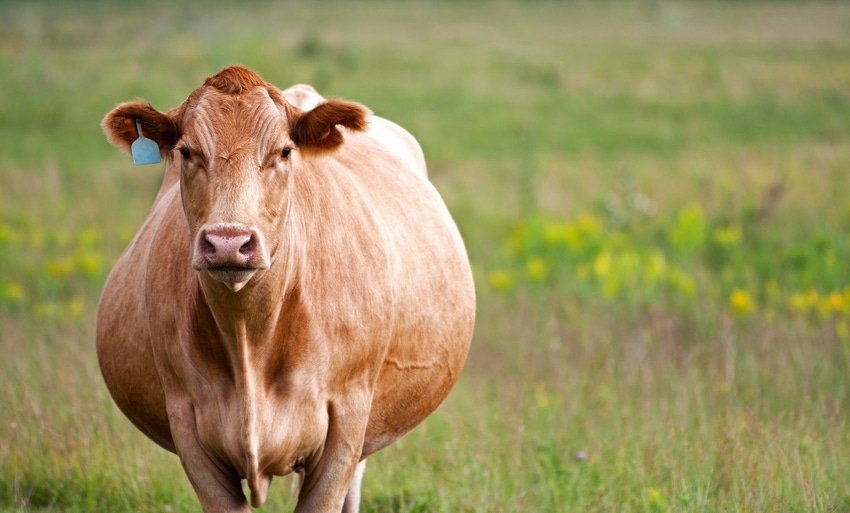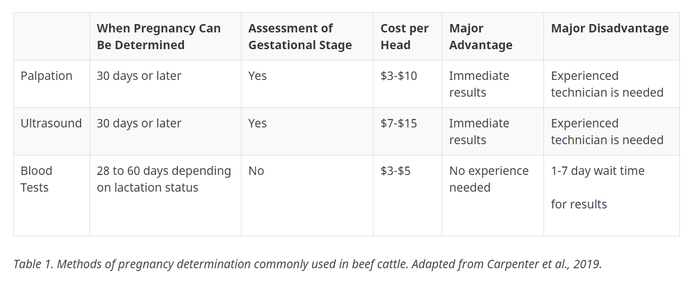Knowing pregnancy status of females allows producers to make more informed and precise management decisions.
May 31, 2023

Knowing the pregnancy status of females allows producers to make more informed and precise management decisions, which increases efficiency and profitability. Open animals can be culled and marketed in a timely manner. Females can be sorted based on pregnancy status and fed to meet their specific nutritional demands. Estimating calving dates allows for more efficient labor during the calving season. Marketing calves can be planned to maximize profitability. It can also allow producers to uncover problems, such as subfertile animals, that may increase production costs. There are three methods of assessing pregnancy status in beef cattle, and each of these is cost effective and simple to implement in any operation.
Methods of pregnancy determination
There are three main methods of pregnancy detection: rectal palpation, ultrasound, and blood tests. Each of these are effective and beneficial but offer their own advantages and disadvantages. For example, both palpation and ultrasound require some experience. This is outlined further in the table below.

It should be noted that diagnosis of pregnancy status is considered an act of veterinary medicine. As such, you should only determine pregnancy on your own herd, and it is unlawful to diagnose pregnancy status for other producers.
Palpation
Rectal palpation is the most commonly utilized method of pregnancy detection. It is a relatively quick, low stress and efficient method. Experienced veterinarians and technicians can detect pregnancy as early as 30 days, and the age of the calf or stage of pregnancy can be determined if the breeding date is unknown. Outside of a secure chute to properly restrain the animal, palpation sleeves and obstetrical lubricant are the only supplies required.
Ultrasonography
Trans-rectal ultrasonography (ultrasound) is very similar to palpation in terms of appropriately restraining the animal and the need for both palpation sleeves and obstetrical OB lubricant. Of course, an ultrasound machine and training to properly use the machine are required. In comparison to palpation, an ultrasound can potentially determine sex of the calf at a certain gestational age. However, electricity is required to run most machines (some may be battery operated), and they can be considered cumbersome to use. The cost of ultrasound is often slightly higher than palpation.
Blood analysis
The third option for pregnancy detection is submitting blood samples to a laboratory that tests for pregnancy specific glycoproteins (PSGs) or pregnancy specific protein B (PSPB, also PSG-1). Companies with commercial tests include BioTracking LLC with the BioPRYN test, IDEXX Laboratories Inc. with the IDEXX bovine pregnancy test, and Genex Cooperative with the DG29 pregnancy test. These commercial tests have 98% to 99% true positive accuracy and 1% to 5% false positive rates. Heifers can be tested as early as 25 to 29 days post-breeding depending on the test used. For mature, lactating females, each test has a different recommended wait time post-calving before sampling. Results can be sent within 24 to 72 hours by email, phone or fax. The main disadvantage in blood tests compared to palpation or ultrasound is the wait time before obtaining results. Cattle would need to be reworked to sort after results are received.
Implementation in beef herds
Pregnancy determination is most beneficial when performed at two different times: 30 to 45 days after the breeding season has ended and again at weaning. Both time points are recommended to determine if a cow gets bred during the breeding season or if she loses the pregnancy. Assessing this gives greater insight into how the infertility or subfertility problems should be managed. If pregnancy detection twice is not feasible, review the advantages for each time point and select the one that works best for your operation. Both time points will uncover reproductive issues in your herd and allow for either marketing or altering the management of open cows to decrease their input costs.
Once cows are determined to be open, the first decision should be whether they will be kept or culled. Any open cows that are kept need to be managed separately from bred cows. This allows for proper nutritional and health management with reduced costs of maintaining open cows. Pregnant animals may even be grouped by stage of gestation, if desired. Identifying early versus late calving cows will be helpful since estimating calving dates allows producers to be more prepared and labor-efficient during the calving season. Furthermore, knowledge of pregnancy status and stage can aid in marketing of the cow or calves. Culling cows warrants a market analysis to decide the best time and sale options.
Economic impact
Many producers unintentionally overlook the damage an open cow can have on profitability. To put this into perspective, annual production costs per cow, which can vary drastically, are often within the range of $500 to $1,200. Production costs combined with the loss of profit from the lack of a calf are detrimental to a producer’s bottom line. Profitability will continue to decline exponentially as infertility rates increase. One of the best and easiest ways to ensure fertility and increase profits is to implement a pregnancy determination program into your herd.
Summary
The benefits of implementing a pregnancy determination program far outweigh the forgone profits and production costs incurred from an open cow. Palpation, ultrasound and blood testing methods each offer their own advantages and disadvantages, but all methods are efficient and accurate. Producers can work with their local extension agent or veterinarian to determine which method works best for their operation. Assessing pregnancy status 30 to 45 days after the breeding season has ended and/or at weaning allows producers to properly manage or market problematic females. Likewise, marketing opportunities are increased when pregnancy status is known.
References
United States Department of Agriculture. Animal and Plant Health Inspection Service. National Animal Health Monitoring System. May 2020. Beef 2017. Beef Cow-calf Management Practices in the United States.
United States Department of Agriculture. Animal and Plant Health Inspection Service. National Animal Health Monitoring System. February 2009. Beef 2007-08. Part II: Reference of Beef Cow-calf Management Practices in the United States.
Carpenter, Bruce B., L.R. Sprott, and Ky G. Pohler. 2019. Determining Pregnancy in Cattle. Texas A&M AgriLife Extension Service.
You May Also Like



